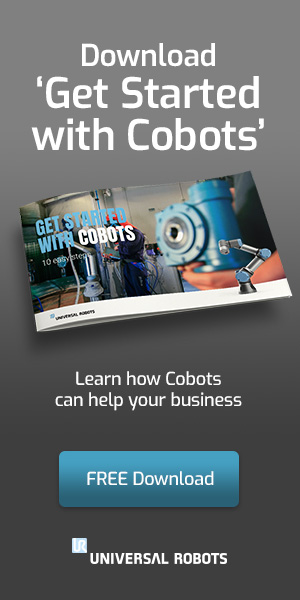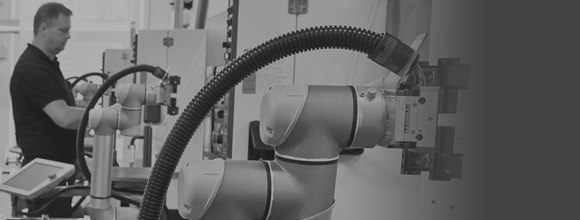
Issue Number 3
Featured Article
What is the Real Cost of Automated Production?

Calculating ROI for California Manufacturers
Nobody buys robots as decorations for the shop floor; they need to make financial sense. In manufacturing, return on investment is king. Determining how long it will take for new hardware to pay for itself is critical. Making a thumbnail sketch of the ROI is easy, but you may be missing some small, but very important factors that together can swing the decision to invest. In this article, we attempt to make a comprehensive list of items that must be considered in these decisions and present some easy formulas to follow.
Manufacturing in California is not the same as manufacturing in the Midwest. We have found most ROI discussions for robots are too broad and do not completely apply to West Coast conditions. California manufacturers face some unique challenges when calculating ROI and may mistakenly believe that automation is not a good option for them.
Some challenges and opportunities for west coast operations are:
- Many short or seasonal runs – most ROI assumes multi thousand piece runs over years.
- High real estate costs – square footage is expensive on the West Coast
- Shortage of skilled labor – general aging of the workforce and migration to less expensive areas
- High environmental and safety costs
- High tax rates with little help from the state for small business
These factors make the flexibility of collaborative robots particularly ideal for these situations.
In the following sections, we examine monetary factors. However, there are other benefits which bring value but may be difficult to quantify. For example, through automation with cobots, improved accuracy and consistency can improve the quality of your product.
Increased quality leads to increased reputation for your company – a very valuable benefit, which must be considered.
1. Determining the Cost of Existing Production
The first step in calculating the ROI for an automated work cell is to determine the yearly operating cost for your manual work cell. For example, let’s examine a situation where we find two employees, one per shift, tending a machine.
There are several factors that contribute to the cost of running your existing cell that you may not think of including:
— The total yearly cost of each employee working in the cell including:
Salary
Taxes
Workers comp
Employee hiring, training and turnover
Vacation, sick and personal time
Safety training, meetings and PPE
Other benefits, retirement plans, etc.
— The percentage of time each employee spends tending this machine
— The total yearly cost of operating the machine including:
Debt service
Maintenance
and repair
Utilities
— The total yearly cost of the hours the equipment spends idle due to:
no employee available to tend the machine (illness, vacations, lunch and break time, cell phone time, non-operating hours etc.)
— The cost of scrapped or damaged parts due to employee error
— The amount of space currently occupied by the existing work cell
The most common mistake when calculating the operational cost of a work cell is underestimating the actual cost of labor.
2. Integrators Can Help Calculate Your Initial Investment
Integrators are the automation professionals who can help you design, price, and install an automated work cell powered by a cobot. Integrators can provide as much or as little help as you want. From selecting the best hardware and assisting with installation and programming to supplying a completely engineered turn-key system fully installed for you on-site, integrators provide the helping hands you need to ensure your automation project is successful. Some of the additional things to consider in the automation cost include:
Cobot mounting & fixturing
in the work cell
End-of-arm tooling
Safety equipment
Integration costs
such as engineering, installation, testing and training
Other hardware
including interfaces, sensors, cameras and scanners
3. Determining the Cost of Automated Production
Experienced integrators will work with you to determine the cost of the work cell after automation. Some things that integrators will have insight on include:
Properly distributing
employee labor costs after automation
Automation equipment maintenance
employee training
and continuing cobot education
Redeployment
of the cobot to other tasks
There are many other aspects of automation with cobots that add value to your investment. Many manufacturers see cost reductions due to more consistent production and decreased scrap rates. Also, particularly when cobots take over portions of dangerous, tedious, or repetitive tasks, manufacturers see reductions in the costs associated with workplace injuries. Increased accuracy and efficiency during automated assembly is valuable, too, and should figure into the operational cost.
4. Calculating Redeployment Costs for Short Production Runs and Flexible Automation
Collaborative robots offer a major level of flexibility that is not found in traditional robotics – ease of redeployment. This is especially valuable in California’s manufacturing environment where production needs often change rapidly. If your business needs the ability to change the parts your cobot is handling on a regular basis, make sure to discuss this with your integrator. They will be able to provide you with flexible solutions to allow you to easily reprogram and redeploy your cobot, sometimes without the need for any additional tooling.
For instance, say that your company has a cobot that tends a CNC machine. The cobot loads stock material and unloads finished product into a quality control area for the operator. A short-run shop may only need to machine a few hundred parts before switching to a new part. With flexible gripping solutions, only a few program points may need to be changed to redirect the cobot on a new mission. Or the entire cobot could be rolled over to work another machine. This reprogramming process, depending on the operation, can take as little as an hour and can be performed by your existing workforce with minimal training.
For another example, let’s examine a semi- automated welding operation. Imagine having your one certified welder oversee the welding performed by multiple cobots. Your welder will spend some time setting up a weld with each cobot while the other cobot welders are working. Utilizing one certified welder to tend and redeploy multiple cobots at the same time significantly increases the efficiency and output of that welder. In this case, redeployment costs would be included directly into the cobots’ operation costs.
To calculate the cost of redeploying your cobot, your integrator will help you consider:
- frequency of redeployment
- time spent reprogramming the cobot for new operations
- additional tooling, if required
These costs, while minimal, should be considered in addition to the operation costs of the automated work cell.
5. Real Property Considerations
Anyone who has occupied a building or a home in California knows how valuable square footage is on the West Coast. Most manufacturers struggle with space while trying to expand. One of the many benefits of automation with cobots is the space saved by automating production.
Unlike traditional robots which require bulky safety cages, guarding, support equipment, and large robots themselves, cobots have a leg up on their traditional counterparts. Cobots are designed to be inherently safe and can work right alongside your existing workforce without the need for additional guarding or other safety apparatus in many applications.
A carefully engineered work cell can use one or more cobots to tend several machines or production lines at the same time while significantly reducing the footprint occupied by the previously unautomated processes.
While you may not assign a cost to every square foot of floor space, reducing the footprint of your manufacturing process allows other aspects of your business to grow. Choosing to save space in your existing workspace by automating instead of leasing or buying additional space can significantly offset your overhead expenses.
Finally, Calculating ROI
With the information you have gathered in the previous sections, you can calculate the return on your investment. See the following formula where i = the initial investment made for your cobot (including associated hardware and installation costs), c = the annual operating cost of the current work cell before automation, a = the annual operating cost of the automated work cell, and r = the annual cost of redeployment:

Universal Robots reports that some manufacturers see their return in just a few months. However, it is more common that automation applications take a year or two to payoff. The nice thing about investing in UR cobots is that they will continue to operate reliably well beyond the return period. Once the cobot pays for itself the first time, it will continue to make the business money with no additional investment.
Carefully considering all the costs and benefits of collaborative robot installations may surprise you. Don’t overlook the cumulative effect of all the small factors when calculating the value of automation for your business.
Calculating ROI for
California Manufacturers
Robot27 Can Help
From conceptual planning to final installation, Robot27 is your helping hand in automation. We provide the services you need – from fully engineered, turnkey automation cells to educating and consulting with your team on in-house projects. Once your cobot cell is successfully operating, Robot27 does not disappear. We are always available to answer your questions, revisit existing projects, or embark on new automation challenges. With support from Robot27’s knowledgeable team, your cobots are in good hands.
Does your cobot need to communicate with other equipment? Robot27 is equipped to handle these situations, too. With over 25 years of software development experience, we can easily streamline your ability to communicate with other machines or perform varied tasks with an easy-to-use interface.
You can learn more about Robot27 at our website – Robot27.com

